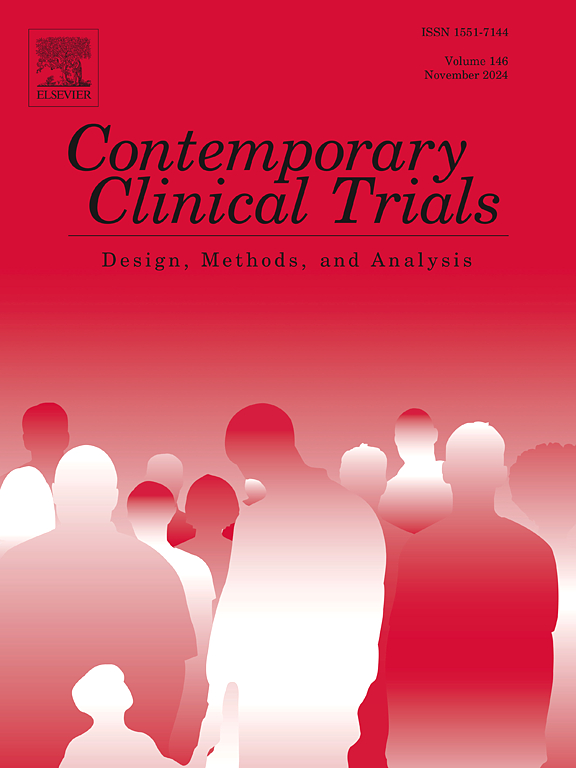设计一项反应过度连续干预(ROCI)随机试验:在paradigm m4tb试验的2C期部分(持续时间范围)实施。
IF 1.9
3区 医学
Q3 MEDICINE, RESEARCH & EXPERIMENTAL
引用次数: 0
摘要
背景/目的:结核病的治疗通常是漫长而复杂的。标准的2臂非劣效性试验已被用于评估较短疗程的治疗方案。新的反应过度持续干预(ROCI)试验设计最近被提出作为优化治疗管理的某些连续方面(例如治疗持续时间)的实用替代方案。方法:我们演示了在TB设置中使用模拟来设计ROCI试验。我们使用paradigm m4tb试验的2C阶段部分(持续时间范围)作为案例研究来说明模拟过程和在模拟中要探索的重要设计考虑因素。与6个月的标准治疗方案相比,paradigm m4tb的2C期旨在优化新治疗方案的持续时间,目的是支持推进到3期试验。结果:ROCI设计将200名患者随机分配到新治疗方案的5个等间隔持续时间组(另外40名患者随机分配到标准治疗方案),足以获得合理的权力,以确定一系列情况下的最佳持续时间。与两两比较相比,用1度分数多项式模型对持续时间-响应曲线建模可以提高选择较短持续时间的能力。新方案的5个持续时间的设计优于3个持续时间的设计,因为在持续时间-反应曲线不平坦的情况下,改进了操作特性。结论:ROCI设计是结核病治疗试验的一种有吸引力的设计选择。ROCI试验的设计可以通过进行模拟研究来探索关键的设计考虑因素。本文章由计算机程序翻译,如有差异,请以英文原文为准。
Designing a response-over-continuous-intervention (ROCI) randomised trial: Implementation in the Phase 2C part (duration ranging) of the PARADIGM4TB trial
Background/Aims
Treatments for tuberculosis (TB) are often long and complicated. Standard 2-arm non-inferiority trials have been used to evaluate shorter durations of treatment regimens. The new response-over-continuous-intervention (ROCI) trial design has recently been proposed as a practical alternative for optimising some continuous aspect (e.g. treatment duration) of treatment administration.
Methods
We demonstrate the use of simulation for designing a ROCI trial in the TB setting. We use the Phase 2C part (duration ranging) of the PARADIGM4TB trial as a case study to illustrate the simulation procedure and the important design considerations to be explored in simulation. Phase 2C of PARADIGM4TB aims to optimise durations of novel treatment regimens, compared to a 6-month standard-of-care treatment regimen, with the aim to support advancement to Phase 3 trials.
Results
A ROCI design randomising 200 patients to 5 equally spaced duration arms of the novel treatment regimen (with an additional 40 patients randomised to the standard-of-care treatment regimen) is sufficient to achieve reasonable power to identify the optimal duration in a range of scenarios. Modelling the duration-response curve with a fractional polynomial model of degree 1 improves power to select shorter durations compared with pairwise comparisons. A design with 5 durations of the novel regimen is preferred to a design with 3 durations, because of the improved operating characteristics in scenarios where the duration-response curve is not flat.
Conclusions
The ROCI design is an appealing design option for TB treatment trials. The design of ROCI trials can be done by conducting simulation studies to explore key design considerations.
求助全文
通过发布文献求助,成功后即可免费获取论文全文。
去求助
来源期刊
CiteScore
3.70
自引率
4.50%
发文量
281
审稿时长
44 days
期刊介绍:
Contemporary Clinical Trials is an international peer reviewed journal that publishes manuscripts pertaining to all aspects of clinical trials, including, but not limited to, design, conduct, analysis, regulation and ethics. Manuscripts submitted should appeal to a readership drawn from disciplines including medicine, biostatistics, epidemiology, computer science, management science, behavioural science, pharmaceutical science, and bioethics. Full-length papers and short communications not exceeding 1,500 words, as well as systemic reviews of clinical trials and methodologies will be published. Perspectives/commentaries on current issues and the impact of clinical trials on the practice of medicine and health policy are also welcome.

 求助内容:
求助内容: 应助结果提醒方式:
应助结果提醒方式:


